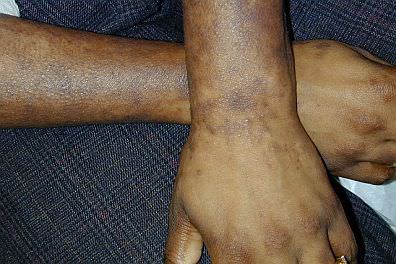Mycosis Fungoides (MF)
What is Mycosis Fungoides (MF)?
 Mycosis fungoides (MF) is the most common type of cutaneous T-cell lymphoma. It is a low-grade lymphoma which primarily affects the skin. Generally it has a slow course and often remains confined to the skin. Over time, in about 10% of the cases, it can progress to the lymph nodes and internal organs.
Mycosis fungoides (MF) is the most common type of cutaneous T-cell lymphoma. It is a low-grade lymphoma which primarily affects the skin. Generally it has a slow course and often remains confined to the skin. Over time, in about 10% of the cases, it can progress to the lymph nodes and internal organs.
What is Sézary syndrome?
Sézary syndrome is the leukemic variant of CTCL. It is exceedingly rare that patients with early stage mycosis fungoides develop Sézary syndrome. The malignant mature T-cells circulate in the blood stream in addition to appearing on the skin surface. Some patients experience abnormal redness of the skin and is sometimes referred to as the "red-man syndrome." Symptoms may include intense itching and scaling.
Who gets it and how common is mycosis fungoides?
There is a greater frequency among men than women and is more common after the age of 50. There are 16,000 to 20,000 cases across the United States and approximately 3,000 cases across Canada. Due to the difficulty of diagnosing the disease in its early stages, these numbers are inexact.
What does it look like?
One of the problems in describing this disease is that it doesn't look the same for all patients. Patches, plaques and tumors are the clinical names of the different presentations. Patches are usually flat, possibly scaly and look like a "rash." Mycosis fungoides patches are often mistaken for eczema, psoriasis or nonspecific dermatitis until a proper diagnosis of mycosis fungoides is made. Plaques are thicker, raised lesions. Tumors are raised "bumps" which may or may not ulcerate. A common characteristic is itching, although many patients do not experience itching. It is possible to have one or all three of these phases. Some people have had the disease for many years and have only dealt with one presentation.
What is the progression of the disease?
The course of mycosis fungoides is unpredictable. Some patients will progress, slowly, rapidly, or not at all. Most patients will only experience skin symptoms without serious complications. About 10% will experience progressive disease with lymph node and/or internal involvement with serious complications. Many patients live normal lives while they treat their disease and some are able to remain in remission for long periods of time.
How is Mycosis Fungoides (MF) diagnosed?
Mycosis fungoides is difficult to diagnose in early stages, as the symptoms and skin biopsy findings are similar to other skin conditions. Mycosis fungoides is frequently misdiagnosed as other skin conditions and patients may go for years with presentation but no proper diagnosis. The clinical picture is most essential (based on both history and examination) followed by biopsy confirmation. Your physician will examine your lymph nodes and order various blood tests including a test for Sézary cells in the blood. Other screening tests such as a chest x-ray or CT scan may be indicated, depending on the patient's history.
What are the causes of Mycosis Fungoides (MF)?
Although there is continuing research, at this time, no single factor has been proven to cause this disease. Studies have failed to show connection between chemical exposure, environment, pesticides, radiation, allergies and occupations. Exposure to Agent Orange may be a risk factor for developing mycosis fungoides for veterans of the Vietnam War, although no direct cause-effect relationship has been established.
Is CTCL contagious?
Mycosis fungoides is not contagious. There is no supportive research indicating that this is a genetic or hereditary disease. There has been recent research investigating the role of viruses, but the results are conflicting and felt to be inconclusive.
How is Mycosis Fungoides (MF) treated?
This is an issue that is specific to each individual depending on the symptoms and stage of the disease. You should be familiar with different treatment options, so you can discuss them with your physician to see what would be best in your situation. Leading treatment modalities include:
- ultraviolet light (PUVA, UVB, narrow-band UVB)
- topical steroids
- topical chemotherapies (nitrogen mustard, carmustine)
- local radiation to a single lesion or total skin electron beam (TSEB)
- photopheresis
- systemic chemotherapy, (given by intravenous infusion) interferon
- topical and oral retinoids (Targretin® capsules and Targretin® gels)
- fusion protein (Ontak®)
These treatments may be prescribed alone or in combination, to achieve the best long-term benefit to you.
Is there a cure for mycosis fungoides?
Unfortunately, to date, there is no known cure for CTCL, but scientists are working hard to find one. It is important to consider the definition of cure. Some patients can be put into long-term remission (several years) with treatment and some patients may achieve a durable remission, which may be considered a cure. The most recent research has indicated that patients diagnosed in early stage (which is 80% of patients diagnosed) will live a normal life expectancy. It is also important to remember that statistics deal with groups of people, not individuals. In the last few years there has been much more research, better treatment options and more collaboration among physicians, which is a positive sign for patients.